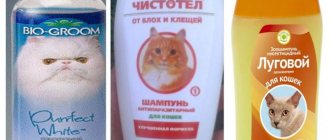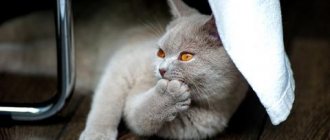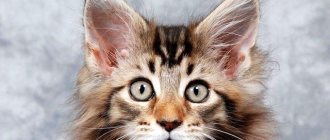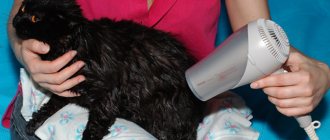How to wash your cat: regular shampoo, soap or special care product
Curious kittens often find themselves in situations where they urgently need to be washed.
Often, the owner’s arsenal lacks the necessary supplies to maintain hygiene. If a careless dirty fellow has soiled the whole house, you need to know how to wash the cat if there is no special shampoo. Under natural conditions, they maintain cleanliness on their own by licking their fur. If the kitten is very dirty, first wipe it with a damp cloth. Wipes soaked in lotion are not suitable for this. Only as a last resort use household chemicals. A clean pet must be wrapped up to prevent it from catching a cold.
How to wash a cat if there is no special shampoo
For regular care of animals, special products are needed. They are less aggressive in composition than regular shampoos. It is best to wash the cat with warm water and beaten egg yolk. If that doesn’t work, you need compounds with PVA.
In rare cases, you can wash cats with regular shampoo or soap, but it is not advisable to do this often. The animal's skin will begin to peel off.
Let's discuss what to choose from what is in the bathroom.
Regular soap
It is not recommended to bathe a kitten with soap with a strong fruity or floral aroma. Bath, pine, and baby soap are preferable. Experienced veterinarians do not advise excessive soaping of the animal.
It is enough to pour it with soapy water or apply foam to the wool. If the surfactants (surfactants) don't touch the skin, great.
You shouldn't bathe your pet too hard. He must have natural protection.
Baby shampoo
Products used to wash children under three years of age are hypoallergenic. They contain less of all kinds of synthetic additives and more natural ingredients. But you can’t get carried away with them either.
The product is pre-diluted 1:3 and foamed well. And then the kitten is treated with foam. You need to carefully clean the face.
Phrases like “washes without tears” are a marketing ploy. When foam gets into the eyes of animals, conjunctivitis develops. The small pet will become restless. Ears are a no-go area. They are cleaned with ear sticks with water, lotion or saline solution.
Regular human shampoo
Some owners use human shampoo to care for their pets, and do this regularly. Veterinarians strictly prohibit doing this. The secretion of fatty glands is disrupted, the skin suffers, and the structure of the hairs changes.
Allergic dermatitis and other skin diseases are possible. Immunity weakens. After washing, cats get sick more often and can get pneumonia.
If there are several hair care products, choose the simplest one. It is better if it contains a decoction of herbs, without dyes or thickeners.
The soap composition is made by diluting the shampoo with water, increasing the volume at least five times. In this case, it will be possible to protect the cat from the consequences and reduce the risk of developing skin diseases.
Tar shampoo or liquid soap
Tar is an excellent folk remedy for skin irritation. Liquid soap or tar shampoo is a good insecticidal remedy for blood-sucking insects.
If your pet constantly scratches itself with its paws or bites something out of its fur, it may have fleas. Try washing it with tar soap. This primitive method is used in folk medicine.
When you urgently need to wash your cat
Cats are capable of taking care of their own cleanliness. They lick their fur several times a day; this behavior is inherent in them by nature. However, there are times when a pet requires additional water treatments. Sometimes the animal needs to be washed urgently. Then the owner is faced with the question: “Is it possible to bathe a cat with regular shampoo?”
Urgent water procedures are necessary in the following cases:
- Pets are thoroughly washed before the exhibition. However, such situations rarely arise. Owners of purebred cats, as a rule, purchase in advance everything they need to prepare their pet for the event.
- If the animal's fur is very dirty and the pet cannot clean it on its own.
- If a toxic substance gets on your cat's fur, it needs to be removed immediately.
- Long-haired cat breeds require frequent washing during the shedding period. Otherwise, licking yourself can lead to hair getting into the stomach and indigestion.
- If the animal has parasites in its fur. But in this case, human shampoos will not help. Special veterinary products are required to remove fleas and ticks.
We invite you to familiarize yourself with: Catalog of Belarusian companies in the field: Pig farming - contacts, services, products
Is it possible to wash a kitten with laundry soap?
The most natural soap is considered to be laundry soap. It is valued for its good cleaning ability. But it is wrong to believe that it is suitable for bathing kittens.
Common people believe that they can wash cats with laundry soap. It’s better not to do this, but to choose a less aggressive one, with a low alkali content or a neutral PH level.
If there is no special shampoo and the kitten needs to be washed, a solution of laundry soap will do. It is suitable as an emergency measure. The cat may develop dandruff and itchy skin after a bath. Some cats experience hair loss, and allergic reactions are possible.
Laundry soap 72% from the era of socialism for a pet is a kind of poison. It is important to rinse the wool well so that the pet is not poisoned by soap components.
If you find problems after washing with laundry soap, you should immediately contact a veterinarian. He will tell you how to minimize the effects of alkaline attack on the skin.
Laundry soap
Laundry soap in the Soviet Union was made according to certain standards and was available in every home: it was used for washing dishes, washing clothes, washing the body and head. One inexpensive soap replaced a huge number of different detergents. This is due to its composition.
Laundry soap contains only sodium or potassium salt and fatty acids. If you add dyes and essential oils to them, you can get toilet soap. If you add various thinning components and, for example, SLS, you can get a well-foaming shampoo alternative. Thus, only two components included in laundry soap are the basis of any cleaning chemical product, so it was used wherever possible.
Laundry soap indicates the percentage of acids
Laundry soap has a percentage designation: 72% means that the product contains the maximum amount of acids. This is a natural, environmentally friendly soap.
The saturated fatty acids included in this product (stearic, palmitic, lauric, and so on) improve the properties of soap to form foam and exhibit washing abilities in both cold and hot water.
If your hands remain sticky after using laundry soap, it contains rosin. This substance promotes the formation of foam and dissolution of the product in cold water, and also increases the shelf life of the soap. If you add sodium silicate to the product, the stickiness will disappear.
If you add bleach to laundry soap, it will turn white.
Now liquid laundry soap has appeared on the market, which has nothing in common with solid laundry soap except the name. It contains toxic substances that can corrode the skin.
Laundry soap not only cleans surfaces well from dirt, but also has antimicrobial properties, so it is often used in medicine in the absence of certain drugs.
After washing the wound, you need to apply gauze soaked in a soap solution. on the wound
Advantages of this product:
- environmentally friendly hypoallergenic product;
- high alkaline balance;
- has antimicrobial properties;
- low cost;
One of the advantages and disadvantages of this product is that due to its high alkaline balance, this soap cannot be used often for washing: alkali harms the skin, and the epidermis loses its elasticity and becomes dry.
Laundry soap has a rather specific smell that is unpleasant even to people, not to mention various insects. Small parasites (for example, fleas) will try to quickly run away from the source of this “amazing aroma.” Laundry soap does not destroy insects, it only repels them, so they can leave your pet, but they will jump around the bathtub and clothes - here you need to kill them.
Also, do not forget that our pets have a different pH level, so their skin may experience irritation from using laundry soap.
against fleas, I can recommend to you (based on my experience) a common, well-known and also very economical remedy called “Laundry Soap”, by the way, it is good at removing not only fleas from animals, but also lice and nits from people.
ksenko
https://www.lynix.biz/forum/kak-izbavit-koshku-ot-blokh-isklyuchiteln0-narodnymi-sredstvami
How to wash a cat: advice from veterinarians
Veterinarians generally do not recommend washing animals frequently.
- The procedures are recommended for adult cats during spring molting so that less fluff accumulates in the stomach and does not cause constipation.
- Cats can only be washed with regular shampoo when nothing else is available. But you need to choose dermatological compositions based on soap root, without lauryl sulfates, dyes, fragrances, and with a small amount of PVA.
- Tar product is used as a flea prevention for kittens from 8-10 weeks of age. After the procedure, the animal cannot be fed for four hours; water must be given. Treatment is carried out no more than once a month. Apply the soapy liquid for 3-5 minutes, then rinse with cool water.
- Do not wash cats with hot water; the functioning of the sebaceous glands is disrupted. It is important to avoid foam getting into your ears, eyes, and mouth.
- Hypoallergenic baby washes can be used for cats if special shampoos are not available. They are not so concentrated. They must be diluted with water. Children's liquid cream soap is safer and better in composition.
- It is important that there are no wounds or scratches on the kitten’s skin. If possible, it is better not to wash a dirty pet; just wipe it with a soft, damp cloth to remove heavy dirt. After such a procedure, he will not get sick, he will get better on his own within a couple of days.
By properly caring for their pet, owners save themselves from unnecessary hassle and trips to the veterinarian. A fluffy meowing pet is not a toy, but a living creature that does not need to be constantly washed with shampoos, they are harmful to it. It is important to protect kittens from water procedures after vaccinations; they are especially vulnerable.
How to properly wash a cat
Some owners of cats and cats think that these clean animals are able to independently maintain the cleanliness of their fur and body.
Considering this belief an undeniable argument, careless cat owners try to wash their pets as rarely as possible, increasing the frequency of this procedure to 1-2 times every couple of years. However, professional breeders are convinced that such an attitude towards animal hygiene on the part of their owners is unacceptable. In representatives of the cat family, like in most living beings, the skin over time becomes covered with a layer of dirt, dust, secretions of the sebaceous glands and other contaminants.
https://www.youtube.com/watch?v=upload
In the absence of timely washing, the layer of dirt and sebum becomes thicker and denser. This not only leads to the fact that the animal begins to look unkempt, but also inevitably causes itching and the development of infectious skin diseases.
In addition, a layer of sebum and dirt, as well as hair that has gathered into tangles and lumps, are ideal conditions for the proliferation of parasites and pathogens of dangerous diseases.
The main reasons why an animal needs bathing:
- pollution of wool and skin;
- molting;
- the appearance of parasites and fleas;
- preparation for the exhibition.
Animals brought home from the street also require a bath.
The ears, neck, abdomen, axillary and inguinal folds are subjected to especially careful examination.
It is important to remember that bathing an animal brought from the street is an extremely difficult, unpredictable and time-consuming job.
There is an opinion that cats need bathing during heat. According to observant breeders, this procedure does not play much importance at this stage of the pet’s life. However, in some cases, bathing may really be necessary - for example, when a cat during estrus gets very dirty, rolling around on the floor in the most unexpected corners of the apartment.
In addition, some cat owners claim that in some cases bathing slightly alleviates the condition of their pets during estrus. According to experienced breeders, during this difficult period for a cat, bathing acts as a distraction.
The washed animal “switches” to putting itself in order, temporarily stops meowing plaintively and wandering around the house in search of a partner.
The frequency of bathing kittens, cats and cats is a very conditional indicator, depending on many factors.
First of all, it is determined in accordance with the individual characteristics of the pet - its breed, length and color of fur, skin type, habits and lifestyle. An important role in the frequency of the procedure is played by where and in what conditions the animal is kept - in a house, a city apartment or on the street.
Animals with medium-length hair require bathing, on average, once every 3-4 months, and long-haired pets - once every 2-3 months.
Light-colored cats and toms are bathed more often than their dark-haired counterparts - about 4 times a year. In general, breeders remind us that animals with semi-long and long hair are not recommended to be washed more than 6 times a year.
The situation is more complicated with sphinxes, whose bathing should be approached with special attention. Some breeders of this breed wash their pets about 2 times a month, others prefer to alternate bathing with wiping their pet with a damp cloth.
In both cases, you should focus on the individual characteristics of the pet (for example, some sphinxes simply love to bathe and swim). It would not be superfluous to consult a veterinarian on the most acceptable frequency of bathing the Sphinx.
After water procedures, it is necessary to place the pet in a dry and warm room without drafts. Leaving the animal after bathing in a cold, drafty room is strictly prohibited.
It is also prohibited to bathe kittens, cats and cats during illness, during the postoperative period and for two weeks after vaccination (vaccination). It is not allowed to bathe kittens in the first months of life, as well as nursing cats and cats in the final stages of pregnancy.
It is better to postpone bathing for a while even if the animal has recently eaten. In this situation, water procedures can provoke vomiting. Also, you should not bathe a pet that has suffered stress or is in a stage of severe fright, excitement, or anxiety.
Cats do not need to be washed daily or weekly; bathing once every 2 months is considered normal. Watching the cat, it is easy to notice that in her free time from playing and feeding, she likes to “preen” - licking her fur, paws and tail. The animal keeps its fur clean on its own, so it does not need regular bathing.
Interesting fact: cats and cats groom themselves differently. Cats spend more time licking their fur and do it more thoroughly than males.
It is important to distinguish between thoroughly washing the cat with shampoo and wiping individual areas of the coat as it gets dirty. If the cat got dirty in the toilet or came home from the street, wipe off the dirt with a soft cloth previously moistened in warm water. This will not harm the pet.
You need to teach a kitten to wash from the age of 4-5 months, so that bathing becomes a habitual ritual, and, as an adult, he would not experience fear of water. In any case, you will have to wash your domestic cat throughout its life, because its fur gets dirty and matted, and you really want the “fur coat” to always be luxurious and well-groomed!
Trim your cat's nails to prevent him from scratching you while bathing.
Comb the fur and remove tangles.
Choose a place for bathing - a bathtub, sink or basin. The bathtub is perfect for large cats; you just need to cover the bottom with non-slip bedding. Many owners wash their pets in sinks. The option with a basin is less convenient, since the cat may begin to grab onto its edges; give preference to a container with a volume of about 30 liters or buy a special bath.
Remove all foreign objects from the sides of the bathtub or sink, hide washcloths and other things that the cat can get caught on.
Make sure you have everything you need to bathe your pet on hand:
- shampoo selected specifically for cats (laundry soap and detergents are not suitable for humans - cats have a different skin Ph);
- a hat that covers the cat's ears, or cotton swabs that can be placed in the ears, or you can tie a small bag on your head like a scarf;
- soft washcloth for washing hair;
- a large towel in which to wrap the cat after washing so that it does not freeze and cannot scratch you;
- standard towel for collecting remaining moisture and drying;
- caring assistant (preferably).
Check the temperature in the room where you are going to wash your cat. Pets can easily become hypothermic and get sick, so the air should be no colder than 22 °C.
Pour water into the bathtub, basin or sink in advance. The cat is more afraid not of the bath itself, but of the sound of water pouring from the tap. Before starting water procedures, add warm water to a level of about 10 cm so that the water reaches the cat’s belly. The animal must stand confidently on its paws, but so that its head does not get wet.
Before the water gets cold and the cat suspects something is wrong, grab her and take her to the bathroom. Talk to your purr gently, do not make sudden movements that could frighten your pet. Don't forget to close the door - if the cat escapes, it will be difficult to catch, and wet paw marks will remain all over the apartment (possibly along with foam, if you manage to soap the cat).
Gently place the cat in the bathtub, basin or sink. During the dive, you can hold it by the scruff of the neck to prevent the pet from breaking free and scratching you. Put a bathing cap on him or put cotton swabs in his ears. Run warm water over the fur, avoiding the eyes, nose and ears.
It is likely that the cat will be unhappy and begin to resist. She will have to be persistent - for her own good. Grasp the cat's shoulders directly under your chest in your left hand if you are right-handed. This way, your dominant hand will remain free and can be used to lather the animal. If the cat is waving its hind legs, then you just need to sit it down and hold it so that it cannot jump and kick.
At this stage, the assistant will make your task much easier - he can water the cat from a watering can or shower, supply shampoo, a towel and other necessary items, and you will do all the manipulations with your free hand.
Note: pet stores suggest using a short leash with suction cups to bathe your cat. This accessory makes sense to use only as a last resort, since the pet may be more afraid of the leash than the washing, and in the future it will be difficult to lure the cat into water treatments.
Now apply shampoo to the wet cat's fur with light massaging movements. Consistently soap your back, chest, belly and tail, don’t forget about your paws and chin. Do not use too much shampoo so that you do not have to wash off the foam for a long time.
Using a special washcloth, gently wash the cat's face. If you want to wash your cat's hair, ask an assistant to pinch his ears or put cotton swabs in them. Also make sure that water does not get into your cat's nose.
It's time to thoroughly rinse your cat's fur. Rinse off the foam strictly from top to bottom. It is convenient to wash off the shampoo with a hand shower, just do not lift it very high. Residues of detergent should not remain on the cat's skin, as this may subsequently lead to irritation.
Let's find out whether it is possible to wash cats with tar soap, laundry soap, children's soap, or regular soap?
Pets need care and attention, so sometimes owners have to force mustaches to undergo water procedures.
Cats are not bathed often. As usual, the need for this manifests itself in cases where the cat, or rather its fur, is heavily soiled or there are other indications, such as the presence of fleas, ticks, and other parasites.
For water procedures, choose specialized weakly alkaline products intended strictly for animals. You can purchase the usual liquid shampoos, gels, shampoo sprays, caring balms and even gentle “cat” soap at veterinary pharmacies.
It is not recommended to bathe animals with human shampoos and ordinary laundry soap. Cat and human skin have different acid-base balance - in cats the pH varies between three and three and a half, and in humans it reaches six.
Therefore, it is not recommended to use non-specialized shampoo for cats. This is fraught with the development of allergies, the appearance of dandruff, dry skin, loss of elasticity and shine of the coat, and its loss. This does not yet take into account individual reactions and possible intolerance.
- CAN YOU WASH YOUR CAT WITH REGULAR SOAP?
- CAN YOU WASH CATS WITH TAR SOAP?
- IS IT POSSIBLE TO WASH A CAT WITH LAUNDRY SOAP?
- IS IT POSSIBLE TO WASH A CAT WITH BABY SOAP?
- USEFUL VIDEO
How to dry wool correctly?
Take the freshly washed cat into the room and dry it with a towel. For short-haired cats, one towel will be enough, and for long-haired cats, do not skimp on 2-3 pieces. You can place your pet on a newspaper or hoe so that the dripping moisture is absorbed faster.
For your information: a cat has a so-called air cushion between its skin and the top layer of fur. This layer of air is heated by the animal's body heat and protects the cat from freezing. During bathing, the fur gets wet and temporarily loses its thermoregulatory properties, which is why it is so important to warm the cat with towels after washing and protect it from drafts.
If the cat is not afraid of a hair dryer, then about 10 minutes after bathing you can lightly dry his fur. The air flow should be warm, but not hot. If the cat is afraid of electrical appliances, it is better to wait until the “coat” dries naturally.
https://www.youtube.com/watch?v=ytcopyrightru
Use a special comb to comb the fur.
After washing, your domestic cat needs to stay warm for at least an hour.
Can I wash my cat with regular soap?
Yes, if you can choose a product with an optimal PH level and track the quality and nature of the other components listed in the composition. It is not recommended to bathe a cat with regular soap or human shampoo for the reasons listed above. Well-groomed hair is important for the cat family, so do not experiment, but use generally accepted and affordable shampoos located on the shelves of any veterinary store.
Is it possible to wash cats with tar soap?
Tar soap, according to many breeders, is a real panacea in the fight against blood-sucking insects. Let's see if this is true. Any animal, even if it is completely domestic, has been infected with fleas at least once in its life, the larvae of which you could bring home on clothes and shoes. Pedigree cats, as well as show cats, are vaccinated against blood-sucking insects once every three months, and special notes are included in the veterinary passport.
Tar soap is a very primitive, cheap, but effective way to combat invasion. Thanks to the phenols, alkalis, citric acid and sodium salts it contains, soap repels insects. Benzene contained in birch tar has a paralytic effect on the nerve centers; alkali has an antiparasitic effect, burning through the shell of parasites.
In relation to insecticidal (antiparasitic) agents, soap with a tar component has a number of advantages:
- Absence of poisons, alkaloids of hazardous substances and heavy metals. Many modern parasite control products contain toxic substances, which is why they should be dosed and used with caution.
- It is allowed to use in the presence of wounds, abrasions, and other skin diseases.
- Tar soap can be used to treat animals against parasites as early as six to eight weeks of age, because it does not dry out the skin and maintains water balance. Even in human medicine it is prescribed as a prevention of skin diseases.
- The biggest danger of using tar soap is that its foam gets on the mucous membranes, as well as in the eyes and ears. Modern insecticidal preparations, when licked by animals, can cause severe forms of poisoning, paralysis and even death.
Disadvantages of using soap:
The larvae and eggs of parasites are insensitive to birch tar - it affects only mature adults. Bathing should be repeated two to three times every four to six days.
Washing a cat with tar soap is easy:
- Place the cat in the bath, wet its fur with warm (up to forty to forty-five degrees Celsius) water.
- Break off a piece of soap and lather until rich foam appears.
- Lather the wool using a bar of soap.
- Hold your pet for three to five minutes, even if he resists.
- Rinse off the foam with water and wrap the cat in a towel. Try to comb out fleas in the area of the ears and face.
- If your pet allows it, comb the fur a couple of times.
Many veterinarians believe that tar soap is a thing of the past, and modern shampoos can quickly and safely deal with parasites. They are not that expensive and are available to everyone.
Each owner must decide for himself what means to treat his pet in order to minimize risks.
Constantly is not possible. Laundry soap has a very hard and heavy structure for cat skin. After using it, dandruff is likely to appear. You may notice other allergic reactions.
It is acceptable to use laundry soap once, in extreme cases, when the animal needs to be bathed urgently, and there is nothing more suitable at hand.
Which shampoo to choose
The older generation often convinces us of the wonderful properties of ordinary laundry soap.
It is good for hair, according to grandmothers, and good for the skin. Still, is laundry soap beneficial or harmful? The effect of laundry soap has different effects on different body systems. Is soap suitable as a hair product? First of all, it’s worth considering that all grandmothers’ talk about the positive effects of soap on hair should raise certain doubts. Production technology in the middle of the last century was noticeably different from modern technology.
Now, for simplicity and effectiveness, a number of chemicals are necessarily added to this kind of soap, so the effect after using modern laundry soap may be unpredictable. Moreover, women of the past era were not spoiled by such inventions as perms, curling irons and hair dryers.
The third, very obvious factor is the individuality of each person. For the same reason, dozens of different types of shampoos have been created, so that you can decide on the one that is right for you. Accordingly, laundry soap cannot become a universal option.
The undeniable benefit of laundry soap is that it contains animal fats. Actually, like many modern hair products. Fat helps with damaged hair with split ends. It provides protection from adverse influences, envelops the hair, leaving curls shiny and smooth. Laundry soap is especially useful in winter.
However, there is also serious harm to laundry soap; it is associated with a high sodium content, that is, alkali. Alkali, on the contrary, has a negative effect on hair. They become weak, dull, thinner, and begin to break. If you still want to wash your hair with laundry soap, you need to neutralize the alkali.
If you still want to try laundry soap, avoid bathing in sea water for a while, as well as masks with salt, to reduce the level of alkali. Be sure to make an appointment with a dermatologist and find out from him whether such a procedure is justified for your hair. In fact, there are many modern products that can help your hair effectively and without consequences.
The same alkali is good for facial skin. It not only destroys bacteria, but also eliminates contamination. It is worth considering that the skin is very dry. Similar results can be achieved using regular antibacterial soap, but sulfates and surfactants will destroy the structure of the skin. That is why laundry soap is definitely more useful in the fight against bacteria and pollution.
After all, a pimple is a fat plug that clogs the hair follicle on the skin and provokes inflammation. It is laundry soap that can break down this fat and restore the normal state of the hair follicle. When squeezing out a blackhead, you injure the walls of the follicle, because of this the infection will expand and infect neighboring follicles. So it is better to use laundry soap.
However, there is also some harm. Drying the skin is also unlikely to have a good effect on its condition. Therefore, when fighting acne, you need to either use laundry soap spot-on, or after washing, actively moisturize the skin with nourishing cream or oils. The second option is relevant if you have a lot of acne and the spot method is not suitable.
Often, laundry soap is a superficial measure in the fight against acne. Acne is often a sign of other diseases in the body. Be it a disturbed metabolism or hormonal imbalance. If acne does not go away after using medicated creams and using laundry soap, make an appointment with a dermatologist. The doctor will order further examination.
Laundry soap has long been known for its antimicrobial effect. This is an excellent antiseptic that is great for hand washing and other household needs. But is laundry soap good for your body and hair?
The soap contains fats (no more than 72%) and a large amount of alkalis, pH level 11-12 (the maximum alkali level permissible for human skin is 9 pH, normal is no more than 5.5). We all know from school that alkali is an aggressive substance that not only destroys bacteria, but also corrodes the skin, heats up, and reacts with other substances.
This soap does an excellent job of destroying dirt and bacteria, so the effect is quick and “on your face.” However, laundry soap also perfectly deals with the protective barrier of the skin and destroys its natural acid balance, which is then very difficult to restore, especially when the skin is sensitive. With daily use of laundry soap, our skin is deprived of protection and does not have time to restore it, so it wears out very quickly.
Laundry soap is especially harmful for children. The constant destruction of the protective barrier of the skin contributes to the penetration of infections, weakening the already weak children's immunity. As a result, the child will often get sick, and various allergies may arise.
To use it or not? There will be no significant harm to your health, but whether you want to remain beautiful after 45 is up to you to decide!
Washing not only with laundry soap, but also with any other soap is extremely harmful to the hair and scalp. Regular hair washing disrupts the natural oil balance of the scalp. Alkali makes hair porous and brittle, completely defenseless against the negative influence of an unfavorable external environment. Over time, hair loses its natural shine, becomes dry and hard, and dandruff appears. A young body can still cope with such shock “therapy”, but after 40 years the hair will thin out greatly and it will be extremely difficult to restore it.
READ What to do if you are bitten or scratched by a cat, including if your hand is swollen after the bite
However, the negative effects of alkali can be avoided. Remember chemistry: acid neutralizes alkali. However, this is a complex process, because you need to choose the right gentle ingredients so as not to damage your hair even more, and also calculate the proportion of acid to water.
No one forbids experimenting with your own hair! But maybe it’s better not to abuse your hair by choosing a more suitable product? If you don’t like shampoos, you can always use natural and completely harmless products, such as homemade ones.
In no case! Washing with laundry soap can seriously disrupt the microflora and cause dryness and cracks in intimate areas. Alkali destroys beneficial milk bacteria, resulting in female diseases. To wash, use only special intimate hygiene products or plain water, but never use soap.
However, using laundry soap only occasionally will not cause any harm, perhaps in some cases even a temporary improvement, because it perfectly kills bacteria. But maybe it’s time to “come out of the caves” and turn to more effective modern means? Which one? Share in the comments.
Laundry soap is best used for household purposes! By the way, if you use soap for washing, do not forget to wear gloves so as not to dry out the skin of your hands. Don’t be afraid to wash children’s underwear with laundry soap - it’s absolutely harmless if you rinse the items thoroughly after washing.
Be healthy and beautiful!
People's secrets of laundry soap! You definitely didn’t know this!
Do you have laundry soap in your apartment? If not, then be sure to buy it and keep it just in case! I have repeatedly heard about its benefits. Once as a child, I was bitten by a neighbor’s dog and my grandmother washed the wound with laundry soap before dragging me to the hospital. And one more time... I screamed and struggled, but granny tried to wash the wound as thoroughly as possible.
And my mother-in-law taught me chicken, all sorts of legs before cooking, always from the household. wash with soap. She is a very cool cook and has been cooking like this for 35 years.
Back then, only cold water flowed in the shower, and laundry soap was provided. But when my father came to get his hair cut, the hairdressers were surprised: such thick hair - and no dandruff at all! Everyone was wondering why he washes his hair like that...
My classmate (it was a long time ago!) had thick, luxurious hair below her butt. Such that she could not comb herself. Everyone gasped after her, but I couldn’t resist asking how she looked after them. The first wash is with shampoo (we wash off the main dirt), then with household items. soap. I tried! Six months later, instead of my three thin hairs, I have cool hair and 0 dandruff. I've been happy with my hair for 9 years now.
One of my friends, on the advice of a teacher, relieved a child of a serious inflammation that was beginning to develop on his leg with the help of laundry soap.
Laundry soap is successfully used to treat inflammatory processes (up to the onset of gangrene)
Even gynecological diseases are successfully treated with laundry soap (in some maternity hospitals it is used to wash the floors in departments where newborns are kept).
Is it possible to wash a cat with baby soap?
If there are no special products for animals on hand, the use of baby soap is not prohibited, especially if it is a hypoallergenic product for the little ones. Shampoos for children are also acceptable, but it is important to remember that the phrase “does not cause tears” is nothing more than an advertising ploy.
When bathing your pet with baby products, take all precautions and be careful not to get soapy water and foam into your eyes, ears, or mouth. Do not overdo it when giving your animal water treatments with baby shampoos. Even the highest quality and most expensive baby soap can negatively affect the skin, causing rashes and allergies.
The widespread production and use of animal detergents is not a simple marketing ploy, but an urgent need. Don’t lose sight of the body’s individual reactions.
If you find it difficult to choose a shampoo or other product that helps bathe your pet, or you encounter allergic reactions and malaise after water treatments, contact the nearest veterinary clinic, you can call.
Qualified personnel will provide the necessary consultations and advice.
Useful video
Visually learn how to wash a cat with tar soap!
Laundry soap was one of the main hygiene products for Soviet citizens. So they used it for washing, washing, and bathing pets. Modern cat owners have access to pet shampoos, but they continue to believe in the amazing properties of laundry soap.
Aggressive components
Lye is included in this detergent. The substance in high concentrations causes burns, and in moderate concentrations it dries out the skin and causes crusts and dandruff to appear.
What are the dangers for a cat when bathing with laundry soap? Allergies, rashes and itching. The pet's fur becomes faded and slick. The hairs become tangled and can only be removed with scissors.
We must not forget that cats constantly lick themselves, and if the remaining soap is not washed off well, the alkali will end up in the animal’s stomach. Several such baths, and poisoning is guaranteed.
Laundry soap does not protect against fleas. You can use it to wash your cat's paws if your pet decides to walk through the mud, or a greasy tail, but carefully wash off any remaining product.
What to bathe with?
There are many cat shampoos sold in pet stores. They clean the fur and get rid of parasites. For one-time use, children's or "adult" shampoo is suitable, but such a cosmetic product cannot be used regularly.










